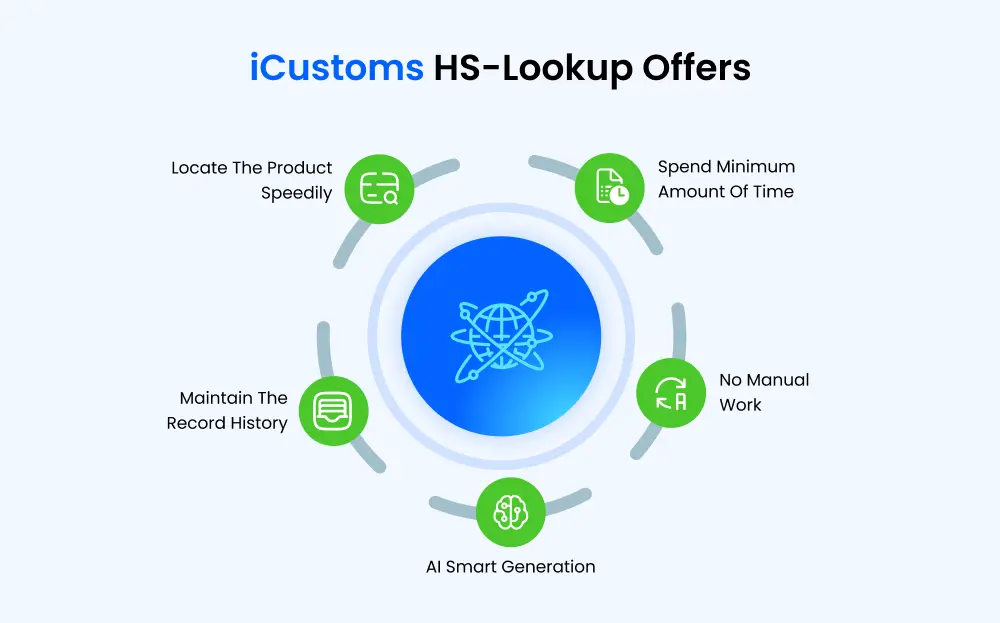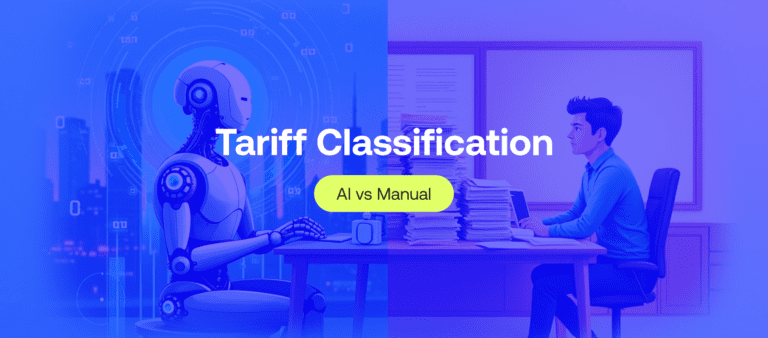Fast & Accurate ENS GB & EU ICS2 Solutions Built for You.
Customs Tariff Classification: Find Commodity codes instantly using iCustoms
-
Freya Jane
- Director of Customer's Success
We all know how traders can use commodity codes to determine HS codes. HMRC’s Harmonised System of Coding aids traders and business owners. HMRC has provided all the relevant information to benefit the company and traders. Customs tariff classification is a new gateway to classifying goods with the help of commodity codes in the UK.
This blog will deliberately give complete details and a guide on how the iCustoms HS code lookup and mapping are streamlining a way for its users to enjoy the smart code lookup method. The HS-code classification product of iCustoms is AI-interpreted, making it unique and novel. Let us learn more about it in the following blog.
What does the customs tariff classification tell?
The Harmonised System (HS), or tariff UK, is the standard for the global trade classification of goods. Products are given numeric designations known as HS codes, HS tariff codes, or HS classes to designate their HS classification.
These codes help customs agencies, importers, exporters, and international organisations trade, collect data, and apply tariffs. The HS code categorisation is structured like a tree, with the root code being a six-digit number.
The first two digits indicate the chapter, providing a high-level product classification. The following two digits provide the heading, which offers a more detailed explanation. The next two numbers denote a subcategory that further specifies the category.
HS code lookup
The insights on establishing the HS code lookup using the iCustoms innovative automation product. They are way simpler than the general guidelines that are given to find the commodity code, such as:
- It is integrated with HMRC, so it gives accurate results.
- Find the commodity codes in the UK with a simple keyword.
- It provides a similar HS-code classification for clearer discrimination
- Saves the history for further use
- It gives results in seconds as soon as you type the keyword
- It gives the advantage of just uploading the data, and the software will intelligently acquire the relevant commodity code.
Read out to find 5 top HS code lookup tools. Click here!
Advantages of customs tariff classification using iCustoms:
Locate the product speedily:
The UK’s commodity codes are easily found by using the HS code lookup product of iCustoms. Find the product to obtain its commodity code.
Spend a minimum amount of time:
The significant advantage it offers is the saving of time. Reduce time but maintain efficiency.
Maintain the recorded history:
iCustoms code lookup lets you keep track of the search history, making it easy.
No manual work:
It has taken away the manual workload, which had higher error chances.
AI smart generation:
iCustoms software is fully automated and designed with high-quality, advanced AI.
The reliability of commodity code checkers
The trustworthiness of a generic code checker is dependent on the application being used. The accuracy and dependability of the numerous commodity code checkers available can vary widely depending on criteria like data provenance, algorithmic precision, and frequency of updates to account for new legislation or reclassifications.
A reliable vendor’s accurate and up-to-date commodity code checker is reliable and trustworthy. Try to find resources based on authoritative sources like government customs offices or intergovernmental organisations.
These tools can help determine international commodity codes, but they should do so with help. Many criteria go into assigning a commodity code, such as the product’s nature and function. If you want to be sure your goods are classified correctly and under the rules, you should talk to some specialists or customs officials.
iCustoms restores customs tariff classification reliability
iCustoms restores the reliability and coherence of the classification of goods and makes them easy to analyse. It ensures that product codes match the global authentication during the verification. Traders can use iCustoms to import in the UK, any part of the EU, and other states.
This customs declaration software offers multiple services other than the commodity code feature. It is a complete package for a trader to submit declarations to HMRC HS codes with a single click.
See how iCustoms AI-powered tool simplifies Tariff Classification. Start Now!
Features of iCustoms product tariff classification
In addition to the coding system, iCustoms engages with traders and resolves all declaration issues. Customs classification ensures a better declaration experience every time and fulfils all necessary and optional requirements.
Let’s examine some of its supplementary offerings:
HS-code Mapping
Definition:
To “map” a product’s characteristics to its HS code is to establish a connection between the two. Nobody does it better when adequately categorising goods for international trade than the Harmonised System.
It is a system of hierarchically organised codes and descriptions for trade-related activities, including customs declarations and statistical analysis.
Importance:
For import and export purposes, precise and consistent product classification is necessitated, making HS code mapping essential. Composure, function, and use must be considered when assigning an HS code.
Products are correctly categorised per the HS classification system and conform to all applicable customs legislation and trade requirements via this mapping procedure.
Benefit:
Businesses can assure compliance, streamline customs clearance, identify appropriate tariffs and charges, and compile precise trade data by correctly mapping products to their associated HS codes.
HS-Code Mapping in iCustoms:
iCustoms HS-mapping is a valuable service that this franchise offers, and because of this, getting an accurate commodity code becomes simpler. If you don’t know the product or code, use relevant keywords for mapping.
The following are the main key features of iclassification :
- 99% Accurate Precision: Harness the power of AI-driven precision to minimise errors and penalties in your import/export operations, ensuring unparalleled accuracy.
- 50% Cost Savings: Simplify your workflow, reduce labour-intensive tasks, and avoid fines with iCustoms IDP, leading to significant cost savings for your business.
- Smart AI Classification: Eliminate manual errors and guesswork by leveraging intelligent AI classification, enhancing the accuracy of your product categorisation.
- Automated Updates: Stay consistently compliant with evolving regulations as iClassification provides automated updates, ensuring your declarations are always in line with the latest requirements.
- Bulk Upload & Process: Handle high volumes of documents with ease and speed using iCustoms IDP, allowing for efficient processing and quick turnaround times.
- HS- Code Lookup: Confidently classify products from anywhere in the world with a comprehensive global code lookup feature, simplifying the complex task of product classification.
- Mass Product Classification: Save time and effort by effortlessly classifying multiple products in bulk, optimising your workflow and boosting overall efficiency.
- Fast & Accurate Identification: Instantly obtain the correct product codes, ensuring fast and accurate identification without the need for manual intervention.
- Fully Automated Workflow: Experience pure efficiency with iClassification’s fully automated workflow, eliminating the need for manual data entry and streamlining your entire process.
- Double-Verification Check: Enhance the integrity of your declarations by implementing a double-verification check, ensuring flawless accuracy in every aspect of your import/export tasks.
- Accuracy at Your Fingertips: Gain valuable insights and optimise future tasks with easy access to accuracy metrics, putting control and precision at your fingertips for strategic decision-making.
Future of Customs with AI
AI and automation have the potential to transform customs as technology develops completely, and customs officials can use these tools to attain unmatched levels of security, accuracy, and efficiency.
- Predictive analytics: Customs officials may proactively address problems and stop illegal activity by using AI-powered predictive analytics to examine enormous volumes of data and find possible risks.
- Robotic Process Automation (RPA): RPA allows customs officers to concentrate on more intricate and strategic duties by automating repetitive operations like data entry, document processing, and form filling.
- AI-powered document analysis: In order to spot mistakes and discrepancies, AI can swiftly and precisely examine customs papers, including invoices and certificates of origin.
Ending Statement:
A business only grows when you fit yourself in the shoes of a customer.
iCustoms fulfils the little necessities of the trader that don’t look beneficial from afar. But when you look closely, using customs tariff classification for goods can provide an entrepreneur with ease, comfort, and unbreakable trust.
Apart from customs tariff classification, it offers multiple varieties that can lessen the burden on a trader from the hectic declaration work. Take a moment to learn about the AI-advanced processes that iCustoms provides for astute businesses.

Spending too much time finding the right HS codes?
Simplify HS code classification with 99% accuracy!
FAQs
What is Customs Tariff Classification?
Assigning a specific code to imported goods, determining duties, taxes, and regulations.
It:
- Helps governments collect revenue (duties & taxes)
- Controls trade by applying different rules to different goods
- Ensures fair competition between domestic and imported goods
Why is accurate Tariff Classification important?
Accurate tariff classification is important to importers because it helps them to avoid overpaying costs and delays, plus stays legal, and for the government, it ensures fair trade, controls goods and gets accurate data.
What are the consequences of incorrect Tariff Classification?
The consequences of incorrect tariff classification can be costly and disruptive for both importers and governments:
For Importers
- Financial penalties
- Delays and disruptions
- Legal repercussions
For Governments
- Loss of revenue
- Unfair trade practices
- Security and safety concerns
- Data inaccuracy
You may also like:
Streamline Product Classification
Uncover iClassification for precise Global Trade, Delivering Time-Saving Accuracy.
Subscribe to our Newsletter
About iCustoms
Streamline Product Classification
Uncover iClassification for precise Global Trade, Delivering Time-Saving Accuracy.


